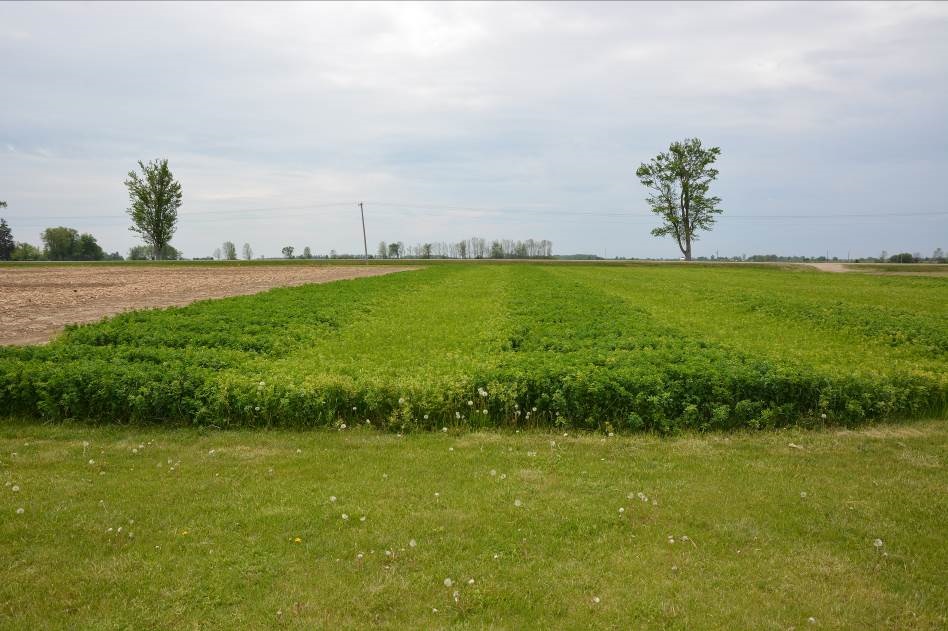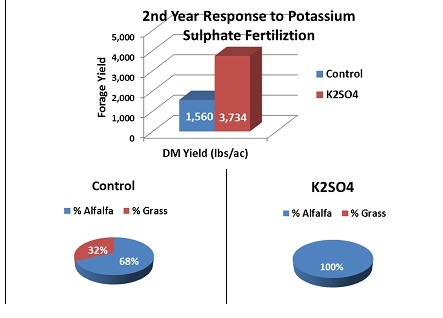Sulphur response in forages
Learn research results on forage response rates to sulphate fertilization.
The need for sulphur (S) supplementation is becoming more obvious. The concerted efforts to reduce acid rain over the last 30 years have resulted in an overall reduction in atmospheric S deposition from 22–27 lb/ac/yr in 1990 to 9 lb/ac/yr in 2010 according to Environment Canada. In light of reductions in free atmospheric S, recent research has been conducted in corn in Ontario which demonstrated variable and inconsistent responses to S. Similar work has been conducted in alfalfa which has demonstrated some very large yield responses.
Sulphur is an essential plant nutrient, important to plants in the building of 2 of the 21 amino acids, and the development of enzymes and vitamins utilized in chlorophyll formation. In legume crops, S has also been demonstrated to play an important role in N fixation.
Alfalfa case study
A 5 year-old alfalfa stand at the FarmSmart Expo site at the Elora Research Station received an application of 200 lb/ac of potassium sulphate (~36 lb S/ac) in three replicated strips in June 2014 compared to unfertilized plots. No other fertilizer had been applied to this stand since it was planted. While no yield measurements were made in 2014, there was a clear response to the fertilizer with the fertilized strips being taller, thicker and much darker green relative to the areas of the field which received no S. These fertilized strips were still visible in the spring of 2015 (Figure 1). Fertilized strips had higher alfalfa content compared to unfertilized, lighter green strips which were mostly grass. Yields were collected from the plots at second cut (July 20). Dry yield and the percentage of grass and alfalfa dry matter were measured and reported in Figure 2.
A strong yield response was observed for the addition of potassium sulphate, with dry-matter yields more than doubling at the Elora site. The yield response was primarily associated with alfalfa, as the alfalfa composition increased from 68% of dry matter in the control (no fertilizer) to 100% in the potassium sulphate treatment.
For response diagnostic purposes, 6" soil samples were pulled in May of 2015 while tissue samples were taken during the late bud stage of regrowth after 2nd cut (Table 1).
A strong yield response was observed for the addition of potassium sulphate, with dry-matter yields more than doubling at the Elora site. The yield response was primarily associated with alfalfa, as the alfalfa composition increased from 68% of dry matter in the control (no fertilizer) to 100% in the potassium sulphate treatment.
For response diagnostic purposes, 6" soil samples were pulled in May of 2015 while tissue samples were taken during the late bud stage of regrowth after 2nd cut (Table 1).
| Treatment | Soil sulphate (ppm) | Tissue S (%) |
|---|---|---|
| Control (No fertilizer) | 0.51 | 0.20 |
| 0-0-50-18S @ 200 lb/ac | 0.10 | 0.28 |
| Element | No fertilizer | 0-0-50-18.5S 200 lbs/ac | Significance |
|---|---|---|---|
| S | 0.21 | 0.28 | The value in the fertilized plots was significantly higher than in the unfertilized plots. |
| N | 3.81 | 4.45 | The value in the fertilized plots was significantly higher than in the unfertilized plots. |
| CA | 2.52 | 2.46 | The value was not significantly different between fertilized and unfertilized plots. |
| P | 0.46 | 0.42 | The value was not significantly different between fertilized and unfertilized plots. |
| K | 2.49 | 2.01 | The value in the fertilized plots was significantly higher than in the unfertilized plots. |
| MG | 0.48 | 0.51 | The value was not significantly different between fertilized and unfertilized plots. |
| ZN | 56.13 | 48.76 | The value was not significantly different between fertilized and unfertilized plots. |
| MN | 28.48 | 27.87 | The value was not significantly different between fertilized and unfertilized plots. |
| CU | 12.21 | 14.4 | The value was not significantly different between fertilized and unfertilized plots. |
| FE | 75.52 | 82.78 | The value was not significantly different between fertilized and unfertilized plots. |
| B | 58.72 | 46.15 | The value was not significantly different between fertilized and unfertilized plots. |
Soil sulphate sampling in May did not appear to be a good predictor of S response at this location, as the non-fertilized plots had higher sulphur levels than the fertilized plots. Large differences in tissue S concentrations were apparent between the fertilized and unfertilized strips, where the unfertilized samples were slightly below the critical concentrations of 0.22% (OMAFRA Agronomy Guide) and the fertilized strips were well above.
Further research
Separate research conducted by Dr. John Lauzon at the Elora Research Station also demonstrated a strong yield response to S as well as a residual S effect the following year. In 2014, S was applied to plots at rates ranging from 5 to 50 lb S/ac, for which strong yield responses were observed. In 2015, higher alfalfa yields were still observed in plots where S had been applied in 2014. Interestingly, yields of these residual plots increased further when an additional 36 lb S/ac was applied to half of each plot in 2015. This suggests that in fields highly responsive to S, annual applications may be necessary to maximize yields.
During the year of application, the form of fertilizer was also shown to be important. When applied in equal amounts, applications of plant-available sulphate fertilizers were able to elicit much greater yield responses than elemental S which must first be converted to sulphate by soil microbes.
While these locations at the Elora Research Station have clearly demonstrated yield response to S, it is not unique. On-farm research conducted by OMAFRA has demonstrated significant yield response to applications of S on alfalfa in some instances at other locations.
A little more on S management
Due in part to its transient nature in soil, no soil tests have been calibrated for sulphur for field crops in Ontario.
Similar to nitrogen, plant available S (sulphate) is also released by mineralization from soil organic matter, and in sulphate form is also susceptible to leaching. Conditions which may favour yield response to S may include fields with fast drainage (ie. sand soils), and those with low organic matter and/or those that do not receive S-containing amendments (ie. manure).
Bottom line:
- Free atmospheric sulfur supply in Ontario has been greatly reduced over the past several decades
- S response has been observed in forages where historically it had not been
- Yield response is typically alfalfa related (increased proportion/yield of alfalfa)
- Sulphate forms of fertilizer provide greatest response during year of application
- Annual applications appear necessary to maximize yield
If you are a forage grower, try some fertilized test strips in your forage fields, particularly if your fields are likely to experience reduced S supply or higher incidence of S loss as described above.

